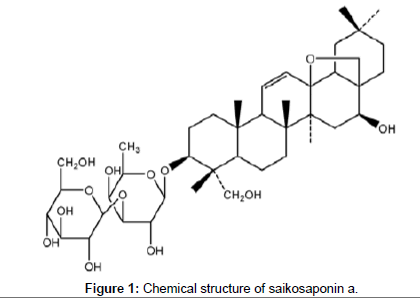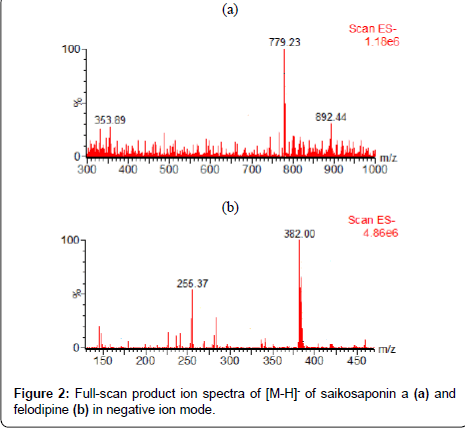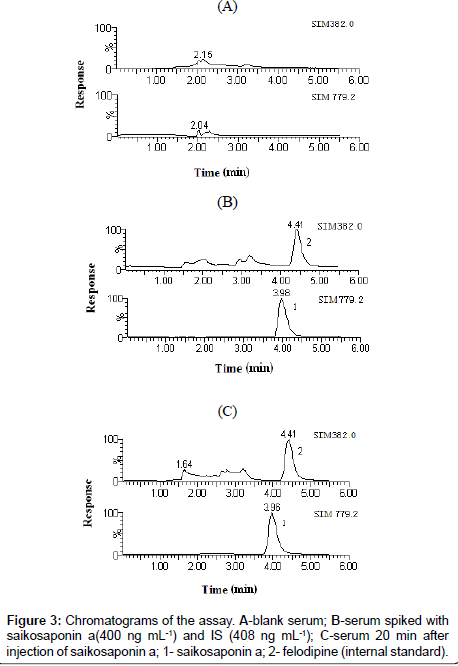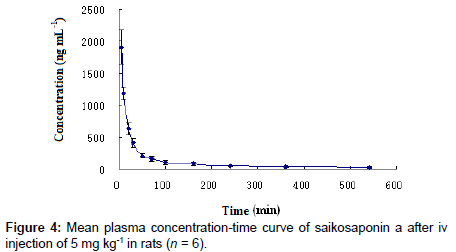Research Article Open Access
Development and Validation of a Liquid Chromatographic/Mass Spectrometric Method for the Determination of Saikosaponin a in Rat Plasma and its Application to Pharmacokinetic Study
Shi-jia Liu1*, Zi-xiu Liu2, Wen-zheng Ju1, Ling Zhou2, Min Chen1, Jun zhang1 and Heng-shan Tan31Affiliated Hospital of Nanjing University of Traditional Chinese Medicine, Nanjing 210029, Jiangsu, China
2Nanjing University of Traditional Chinese Medicine, Nanjing 210029, Jiangsu, China
3General Hospital of Nanjing Military Base, Nanjing 210002, Jiangsu, China
- *Corresponding Author:
- Shi-jia Liu
Affiliated Hospital of Nanjing University of Traditional Chinese Medicine
Nanjing 210093, China
Tel: 86-25-86617141
Fax: 86-25-86555033
E-mail: snow8185@yahoo.com.cn
Received date: September 13, 2010; Accepted date: October 11, 2010; Published date: October 13, 2010
Citation: Liu SJ, Liu ZX, Ju WZ, Zhou L, Chen M, et al. (2010) Development and Validation of a Liquid Chromatographic/ Mass Spectrometric Method for the Determination of Saikosaponin a in Rat Plasma and its Application to Pharmacokinetic Study. J Anal Bioanal Tech 1:104. doi: 10.4172/2155-9872.1000104
Copyright: © 2010 Liu SJ, et al. This is an open-access article distributed under the terms of the Creative Commons Attribution License, which permits unrestricted use, distribution, and reproduction in any medium, provided the original author and source are credited.
Visit for more related articles at Journal of Analytical & Bioanalytical Techniques
Keywords
Liquid chromatography–mass spectrometry; Electrospray ionization; Pharmacokinetics; Saikosaponin a; Felodipine
Introduction
Chaihu (Radix bupleuri, Chinese thorowax root) is a favorite medicinal herb in traditional Chinese medicine (TCM) and is used as a key ingredient herb for many Chinese multiherb remedies. There are 40 species of the Bupleurum grown wide in china, while only two of them, the dried roots of Bupleurum Chinese DC., known in commerce as ‘Bei chaihu’ (Northern Chinese Thorowax Root) and the dried roots of Bupleurum scorzonerifolium Wild., known as ‘Nan chaihu’ (Southern Chinese Thorowax Root), are used in therapeutic practice. In China, Radix bupleuri is traditionally used to relieve fever, to calm the liver and to cure drooping and ptosis [1].
Three major oleanane saponins named saikosaponin a (structure shown in Figure 1), saikosaponin c, saikosaponin d and many minor saponins have been isolated from Radix bupleuri. Saikosaponins have also been reported to possess antiviral activity against hepatitis B virus, measles virus and herpes simplex virus [2,3]. In addition, saikosaponins have been shown to possess antibacterial, antihepatitis and immunomodulating properties [4,5]. In The Chinese Pharmacopeia (The State Pharmacopoeia Commission of China, 2005) Saikosaponin a is defined as the quality control specification for Radix bupleuri and in many Chinese traditional medicines prescribed with Radix bupleuri, the quantity of Saik osaponin a is also assayed to control the quality of the compound recipes.
To control the quantity of Saikosaponin a in plant materials or recipes, several analytical methods have been developed during the last decade. It generally used LC or LC-ELSD [6-8 ] determine saikosaponin a. However, the absorption wavelength of saikosaponin a is 205 nm, lying on the terminal of ultr aviolet. So it has serious interference in determine saikosaponin a. Zhu et al. [9,10] reported the production of monoclonal antibodies (MAb) against saikosaponin a and development of enzyme-linked immunsorbent assay (ELISA) for determination of saikosaponin a in a crude extract of Radix Bupleuri and Kampo medicines using an anti- saikosaponin a MAb. HPLC with a mass spectrometer detector (LC-MS) [11–14] showed superior sensitivity and selectivity compared to HPLC-UV methods.
In this study, a simple and highly sensitive LC-MS method was developed for the determination of saikosaponin a in rat plasma. Study on the Pharmacokinetics of the saikosaponin a in rats makes reference for the absorbation and metabolism in vivo.
Experimental
Reagents and chemicals
Sai k osaponin a and the reference substance of felod ipine were purchased from NICPBP (National Institute for the Control of Pharmaceutical and Biological Products, China. batch number: 110777-200405 and 100717-200501). Water was produced by a Millipore (Bedford, MA, USA) Milli-Q water system. Methanol and acetonitrile (Merck, Germany) were of LC-grade.
Animals
The experimental animals were Sprague-Dawley rats from Shanghai SIPPR/BK experimental animal Co., Ltd. Ltd, weighing 230±20 g. The study was approved by the Animal Ethics Committee of the Nanjing University of Traditional Chinese Medicine. The animals were cared for according to the regulations of the Animal Committee.
Instrumentation and LC-MS conditions
An Alliance 2695 LC system (Waters, Milford, MA, USA) coupled with a triple-quadrupole tandem Waters Quattro Micro mass spectrometer was used. The Mass Lynx 4.1 software was used for instrumental control and for acquisition and processing of the data. AMS detector with an electrospray ionization (ESI) interface in negative ion mode (ESI-) was used for quantitative analysis, with acquisiton in SIM mode. The m/z ratios [M-H]-, m/z=779.2 for saiko saponin a and [M-2H ]-, m/z=382.0 for felod ipine were recorded simultaneously.
LC separation was performed on an Agilent Zorbax SB-C18 (150 mm×2.1 mm, I.D,5 µm) column (Agilent Technologies, Wilmington, DE, USA) with a Security Guard (12.5 mm×2.1 mm, I.D.5 µm) column (Agilent Zorbax SB-C18, DE, USA), kept at 30°C. The s ensitivity of MS detection is directly dependent on the number of ions produced from the mobile phase in the interface. It is expected that mobile phase additives will affect the sensitivity of LC–MS. Use of neutral buffer (ammonium acetat e or ammonium formate) or weak acid (acetic acid) led to good response compared with use of alkaline solution. On the basis of these results, the mobile phase, consisting of methanol and deionized water containing 0.1% ammoni um acetate (84:16, v/v), a flow rate of 0.2 mLmin-1 was selected as mobile phase additi ve for detection of saiko s aponin a.
The optimized electrospray conditions were: detect voltage: 3.5 KV; cone voltage: 57 V; source temperature: 120°C; desolvation temperature: 350°C; desolvation gas flow (nitrogen): 500 L h-1. On the basis of these results to achieve high sensitivity, symmetrical peaks and good separation of the analyte.
Preparation of standard and quality qontrol (QC) samples
Stock solutions of saikosaponin a (478 µg mL-1) and felodipine as an internal standard (408 ng mL-1) were prepared in methanol. The stock solutions were protected from light and kept at 4°C until used. The stock solutions were successively diluted with methanol to prepare working solutions just prior to use. These solutions were spiked into drug-free rat plasma samples to give final concentrations of 10, 25, 50, 100, 250, 500,2500,5000 ng mL-1 Quality control (QC) samples were prepared to the target concentrations of approximately 40, 400, 4000 ng mL-1 in the same way as the plasma samples for calibration. Standard calibration samples and QC samples were stored at -20°C until use.
Sample preparation
To each of dispos able plastic tubes with 100 µL plasma samples (calibration standards, QC samples, pharmacokinetics plasma samples), 10 µL of I.S.(felodi pine, 408 ng mL-1) was added except the blank plasma sample. After vortexed for 30s, 300 µL of acetonitrile was added to each of these plasma samples. The obtained solution was vortexed for 3 min at room temperature. The mixture was centrifuged at 12,000 rpm for 10 min. An aliquot of 320 µL of the upper organic layers were transferred to polyp r opylene tubes and evaporated to dryness in the centrifugal thickener (Centrivap console, Labconco Co, USA) at 50L for 120 min. The residue, dissolved into 100 µL mobile phase, was vortexed for 2min and then centrifuged for 10min at 12000g. 10 µL supernatant was injected into the LC/MS/MS system for analysis.
Method validation
The method validation assays were carried out according to the currently accepted U.S. Food and Drug Administration (FDA) bioanalytical method validation guidance [15]. The method was fully validated for its specificity, linearity, lower limits of quantification (LLOQ), accuracy and precision. To evaluate assay specificity, six independent lots of rat blank plasma were analyzed for excluding any endogenous co-eluting interference by comparing them with the assay of plasma spiked with analytes. The precision was calculated as the relative standard deviation (RSD) a nd the accuracy was evaluated as analytical recovery. For validation of the bioanalytical method, accuracy and precision should be determined using a minimum of five determinations per concentration level (excluding blank samples). The mean value should be within 15% of the theoretical value, except at LLOQ, where it should not deviate by more than 20%. The precision around the mean value should not exceed 15% of the CV, except for LLOQ, where it should not exceed 20% of the CV. Intra-day precision and accuracy were evaluated at three different plasma concentrations (40, 400, 4000 ng mL-1) by replicate analytes of five spiked plasma samples on the same day. The inter-day precision and accuracy determinations were carried out on three different days. Recovery experiments were performed by comparing the analytical results of extracted samples at three concentrations with pure standards without extraction. The LLOQ was considered as the concentration that produced a signal-to-noise (S/N) ratio greater over 10. The sample solution stability was assessed at three concentration levels (40, 400, 4000 ng mL-1). The freeze and thaw stability study samples at three concentrations were stored at -20°C and subjected to two freeze–thaw cycles. The short-term stability of saikosaponin a during storage in the autosampler at 4°C, was performed by repeated injection every 2 h for a period of 10 h. The long-term stability of saikosaponin a in plasma was assessed in three concentration levels after storage at -20°C for 4 weeks.
Application for pharmacokinetic study
Plasma samples were collected at 0.5, 1.0, 1.5, 2, 3, 4, 6, 8, 10, 12 h before and after single intragastric administration of saikosa ponin a at 50 mg kg-1 to six Sprague-Dawley rats under fasted conditions. Other preparations were made immediately after drug administration and six rats were given a dosage of saikosaponin a solution at 5 mg kg-1 by intravenous injection. Plasma samples were collected at times of 5, 10, 20, 30, 50, 70, 100, 160, 240, 360 and 540 min after dosing, 400 µL of blood samples were collected in the heparinized tubes. Then centrifuged for 10 min at 3000 rpm; the supernatant was transferred to labeled plastic vials at -20°C until analysis was carried out.
Results and Discussion
Chromatography and mass spectrometry conditions
The analyte and IS both formed predominantly deproto n ated molecules [M-H]- in the full scan spectra, with m/z at 779.2 for saikosaponin a and 382.0 for IS (Figure 2). Under the current optimized LC and MS conditions, the retent ion times for saikosaponin a and felodipine (IS) were 3.96 and 4.41 min, respectively. Figure 3 shows the typical chromatograms of a blank plasma sample, a blank plasma sample spiked with saikosaponin a and IS and a plasma sample collected after injection of saikosapon in a. No significant interference from endogenous substances with analyte or IS was detected. The overall chromatographic run time was finished within 5.5 min.
Linearity of calibration curves and lower limits of quantification
The calibration curves were constructed by calculating the peak area ratios (Y) of saikosaponin a to IS against saikosaponin a concentrations (X). The regression equation of the standard curve was: Y = (0.00491±0.00015)X - (0.04093±0.02563) (n = 5), with a correlation coefficient over 0.999. It showed good linear relationships between the peak area ratios and the concentrations. The assay was linear over a concentration range from 10 to 5000 ng mL-1, The lower limit of quantification (LLOQ) obtained in this method was 10 ng/mL. At the LLOQ level, the intra-day precision was 4.3% and the accuracy was 96.9%. The LLOQ was considered as the concentration that produced a signal-to-noise (S/N) over 10. With the present LLOQ, the concentrations of saikosaponin a in rats could be determined 540min after intravenous injection of 5 mg kg-1 saikosaponin a.
Recovery a nd matrix effect
Different solvents for the extraction of saikosapon in a from rats plasma have been reported. During the method development, we tried using less toxic solvents suchas ether, methanol and acetonitrile for the extraction of saikosaponin a, but did not obtain a good recovery of saikosaponin a until the centrifuga l thickener was employed. In this paper, centrifugal was developed compared with a simple and efficient liquid-liquid extraction. The recoveries of saikosapon in a determined at 40, 400, 4000 ng mL-1 were 82.6±7.6%, 87.1±6.1% and 81.8±3.4%, respectively, while the recovery of the IS determined at 408 ng mL-1 was 83.0±4.6% (Table 1) These results were indicative of good recovery.
| Sample | Spiked conc. (ngmL-1) | Recovery (%) | Matrix effect (%) |
| saikosaponin a | 40 | 83±8 | 92±9 |
| 400 | 87±6 | 93±7 | |
| 4000 | 82±3 | 89±8 | |
| felodipine | 408 | 83±5 | 96±6 |
Table 1: Recovery of saikosaponin a (mean±standard deviation (SD) and felodipine (internal standard).
The matrix effect of blank plasma in the six batches spiked after the sample preparation with 40, 400, 4000 ng mL-1 of saikosaponin a were found to be within the acceptable range (Table 1). The same evaluation was performed on the IS and no significant peak area differences were observed (Table 1). Thus, we concluded that ion suppression or enhancement from plasma matrix was negligible for this assay.
Accuracy and precision
QC samples at three concentrations were analyzed in five replicates for determining the accuracy and precision of this method. The results were shown in Table 2. The intra-batch accuracy for saikosaponin a ranged from 95.2 to 103.7% at the tested concentrations with the precision (RSD) between 3.0 and 4.8%. The inter-batch accuracy for saikosaponin a ranged from 95.1 to 99.9% at three different concentrations with the precision (RSD) between 8.4 and 10.1%. These results indicated that the present method has a satisfactory accuracy, precision and reproducibility.
| Concentration (ngmL-1) | Intra-day (overall mean, n = 5) | Inter-day (overall mean, n = 15) | ||||
| Conc. found (ngmL-1) | Accuracy (%) | CV (%) | Conc. found (ngmL-1) | Accuracy (%) | CV (%) | |
| 40 | 42 | 104 | 4 | 40 | 99 | 10 |
| 400 | 412 | 103 | 3 | 400 | 100 | 10 |
| 4000 | 3809 | 95 | 5 | 3805 | 95 | 8 |
Table 2: Intra- and inter-day accuracy and precision of saikosaponin a assay in rat plasma.
Stability
Results of the short-term stability, freeze/thaw stability, autosampler stability and long-term stability are shown in Table 3. The mean percentages of deviation of calculated versus theoretical concentrations were less than or equal to10.8% for short-term stability, less than or equal to 14.0% for freeze/thaw stability, less than or equal to 10.5% for autosampler stability and less than or equal to 13.6% for long-term stability. The good stability of saikosaponin a simplified the precautions needed for laboratory manipulations during the analytical procedures.
| AL nominal conc. (ngmL-1) | |||
| 40 | 400 | 4000 | |
| Room temperature (4 h) Measured conc. (ngmL-1) Accuracy (%) |
43±4 | 380±15 | 3799±129 |
| 108±11 | 95±4 | 95±3 | |
| Three freeze/thaw cycles Measured conc. (ngmL-1) Accuracy (%) |
42±6 | 424±26 | 3735±129 |
| 104±14 | 106±7 | 93±3 | |
| Autosampler rack for 24 h Measured conc. (ngmL-1) Accuracy (%) |
39±1 | 377±42 | 4028±180 |
| 97±3 | 94±11 | 101±5 | |
| Stored at -20â??for 1month Measured conc. (ngmL-1) Accuracy (%) |
40±5 | 393±20 | 3652±124 |
| 99±14 | 98±5 | 91±3 | |
Table 3: Stability of saikosaponin a (n = 3, mean±SD).
Pharmacokinetic study
The well-validated method was successfully applied to determine the plasma concentrations of saikosapon in a in rats following a single caudal vei n administration of saikosaponin a (5 mg kg-1). Pharmacokinetic parameters were calculated using the DAS pharmacokinetic software package (Beijing Bosom Science & Technology Co. Ltd). The time-plasma concentration profile of saikosaponin a was depicted in Figure 4. The partial main pharmacokinetic parameters of this study are shown in Table 4. The Cmax and Tmax of asiaticoside were 1907±342 ng mL-1 and 5 min and t½ was 100.6±9.60 min. However, by the intragastric administration groups , the absorbed amount of drug leads to very low concentrations in the circulation, lower than a few ngmL-1, the low absorption indicated that the bioavailability of saikosaponin a is very low. Obviously, the previously reported method based on LCUV cannot satisfy the requirements of the pharmacokinetics study on saikosaponin a, whereas the present method based on LC-MS with a LLOQ of 10 ng mL-1 was sensitive for the pharmacokinetics research of saikosapon in a.
| Parameter | saikosaponin a |
| Tmax(min) | 5 1907 ± 342 64370 ± 4923 69678 ± 5459 100.6 ± 9.60 0.0867 ± 0.0132 21.89 ± 4.61 |
| Cmax(ng·mL-1) | |
| AUC0-tn( ng·mL-1·min-1) | |
| AUC0-∞( ng·mL-1·min-1) | |
| T1/2β(min) | |
| CL(L·min-1) | |
| Vd(L) |
Table 4: Pharmacokinetic parameters of intravenous saikosaponin a (5 mg kg-1) in rats (n=6).
Conclusion
A LC-MS assay for the simultaneous saikosapon in a and felodipine (IS) plasma concentration was developed. The main advantages of this method are: (1) small amount of sample required (100 µL of plasma); (2) processing is simple and rapid; (3) excellent recovery; and (4) short analytical time. The new method was successfully applied to the characterization of pharmacokinetics of saikosapon in a in rats after intravenous injection. While there are only few pharmacokinetics data published on saikosaponin a, this simple, accurate, precise and robust analytical method could be useful for such studies.
Acknowledgement
This project was support by Key Technologies R&D Program of China (2006BAI14B07).
References
- Chinese Pharmacopoeia Commission, Pharmacopoeia of People’s Republic of China, vol 1, Chemical Industry Press, Beijing, 2005 (English Edition) p 196.
- Chang JS, Wang KC, Liu HW, Chen MC, Chiang LC, et al. (2007) Sho-saiko-to (Xiao-Chai-Hu-Tang) and crude saikosaponins inhibit hepatitis B virus in a stable HBV-producing cell line. Am J Chin Med 35: 341-351.
- Ushio Y, Abe H (1992) Inactivation of measles virus and herpes simplex virus by saikosaponin d. Planta Med 58: 171-173.
- Chen SM, Sato N, Yoshida M, Satoh N, Ueda S (2008) Effects of Bupleurum scorzoneraefolium, Bupleurum falcatum and saponins on nephrotoxic serum nephritis in mice. J Ethnopharmacol 116: 397-402.
- Kang SJ, Lee YJ, Kim BM, Kim YJ, Woo HD, et al. (2008) Effect of Bupleuri Radix extracts on the toxicity of 5-fl uorouracil in HepG2 hepatoma cells and normal human lymphocytes. Basic Clin Pharmacol Toxicol 103: 305-313.
- Li XQ, Gao QT, Chen XH, Bi KS (2005) High performance liquid chromatographic assay of saikosaponins from radix Bupleuri in China. Biol Pharm Bull 28: 1736- 1742.
- Ohtake N, Nakai Y, Yamamoto M, Sakakibara I, Takeda S, et al. (2004) Separation and isolation methods for analysis of the active principles of Sho-saiko-to (SST) oriental medicine. J Chromatogr B Analyt Technol Biomed Life Sci 812: 135-148.
- Park IS, Kang EM, Kim N (2000) High-performance liquid chromatographic analysis of saponin compounds in Bupleurum falcatum. J Chromatogr Sci 38: 229-233.
- Zhu SH, Shimokawa S, Tamaka H, Shoyama Y (2004) Development of an assay system for saikosaponin a using anti-saikosaponin a monoclonal antibodies. Biol Pharm Bull 27: 66-71.
- Zhu S, Shimokawa S, Shoyama Y, Tanaka H (2006) A novel analytical ELISAbased methodology for pharmacologically active saikosaponins. Fitoterapia 77: 100-108.
- Bao Y, Li C, Shen H, Nan F (2004) Determination of saikosaponin derivatives in Radix bupleuri and in pharmaceuticals of the chinese multiherb remedy xiaochaihu-tang using liquid chromatographic tandem mass spectrometry. Anal Chem 76: 4208-4216.
- Liau BC, Hsiao SS, Lee MR, Jong TT, Chiang ST (2007) Quality control of Chinese medicinal preparations LC/ESI(+)/MS/MS analyses of saikosaponins-a and -c as markers of Bupleuri radix samples. J Pharm Biomed Anal 43: 1174-1178.
- Huang HQ, Zhang X, Lin M, Shen YH, Yan SK, et al. (2008) Characterization and identification of saikosaponins in crude extracts from three Bupleurum species using LC-ESI-MS. J Sep Sci 31: 3190-3201.
- Liu L, Cheng Y, Zhang H (2004) Phytochemical analysis of anti-atherogenic constituents of Xue-Fu-Zhu-Yu-Tang using HPLC-DAD-ESI-MS. Chem Pharm Bull 52: 1295-1301.
- US Department of Health and Human Services (2001) Food and Drug Administration,Center for Drug Evaluation and Research (CDER), Guidance for Industry, Bioanalytical Method Validation.
Relevant Topics
Recommended Journals
Article Tools
Article Usage
- Total views: 15139
- [From(publication date):
November-2010 - Apr 04, 2025] - Breakdown by view type
- HTML page views : 10493
- PDF downloads : 4646




